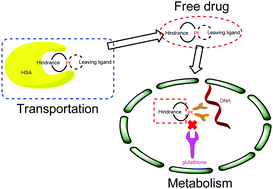当前位置:
X-MOL 学术
›
Metallomics
›
论文详情
Our official English website, www.x-mol.net, welcomes your feedback! (Note: you will need to create a separate account there.)
Insight into the antitumor actions of sterically hindered platinum(ii) complexes by a combination of STD NMR and LCMS techniques.
Metallomics ( IF 3.4 ) Pub Date : 2020-02-05 , DOI: 10.1039/c9mt00258h Zhimei Wang 1 , Lei Fang 1 , Jian Zhao 1 , Shaohua Gou 1
Metallomics ( IF 3.4 ) Pub Date : 2020-02-05 , DOI: 10.1039/c9mt00258h Zhimei Wang 1 , Lei Fang 1 , Jian Zhao 1 , Shaohua Gou 1
Affiliation

|
Sterically hindered platinum(ii) complexes have shown great advantages in overcoming platinum drug resistance. In this study, the antitumor actions of sterically hindered platinum(ii) complex 1 (cis-dichloro[(1R,2R)-N1-(2-fluorobenzyl)-1,2-diaminocyclohexane-N,N']platinum(ii), C13H19FPtCl2) were investigated by using saturation transfer difference nuclear magnetic resonance (STD NMR) and liquid chromatography-mass spectrometry (LCMS) techniques. STD NMR was applied to study the HSA (human serum albumin) binding properties, while the interactions between guanosine 5'-monophosphate (5'-GMP) and complex 1 were studied by LCMS. For HSA binding experiments, strong STD signals were observed for protons of sterically hindered parts of carrier ligands, indicating that the sterically hindered moieties of the carrier ligand could be situated inside the binding pocket of HSA. A 19F NMR experiment indicated that complex 1 could interact with HSA. Furthermore, the binding modes of complex 1 with guanosine 5'-monophosphate (5'-GMP) were studied in the absence and presence of glutathione by LCMS. According to the HPLC profiles, a mono-functional binding mode was observed for complex 1 both in the presence and in the absence of glutathione, while a bi-adduct was observed for Pt(DACH)Cl2, which may be one of the reasons for their different biological activities. Hence, this study demonstrated that the NMR method combined with the LCMS technique could provide valuable information to understand the transport and the underlying anticancer mechanisms of the platinum(ii) complex at the molecular level. Moreover, the results reported here can help to reveal the binding mechanisms of the sterically hindered platinum(ii) compounds with biomolecules, which may shed light on the design of novel platinum(ii) anticancer agents with suitable sterically hindered groups.
中文翻译:

通过STD NMR和LCMS技术的结合,深入了解位阻铂(ii)配合物的抗肿瘤作用。
受位阻的铂(ii)配合物在克服铂药物耐药性方面显示出巨大优势。在这项研究中,空间位阻铂(ii)配合物1(顺-二氯[(1R,2R)-N1-(2-氟苄基)-1,2-二氨基环己烷-N,N']铂(ii)的抗肿瘤作用,C13H19FPtCl2)通过使用饱和转移差分核磁共振(STD NMR)和液相色谱-质谱(LCMS)技术进行研究。用STD NMR研究了人血清白蛋白(HSA)的结合特性,同时通过LCMS研究了鸟苷5'-单磷酸酯(5'-GMP)与复合物1之间的相互作用。对于HSA结合实验,对于载流子配体的空间位阻部分的质子,观察到强STD信号,这表明载体配体的空间位阻部分可能位于HSA的结合口袋内。19 F NMR实验表明配合物1可以与HSA相互作用。此外,通过LCMS研究了在不存在和存在谷胱甘肽的情况下复合物1与鸟苷5'-单磷酸酯(5'-GMP)的结合模式。根据HPLC谱图,在存在和不存在谷胱甘肽的情况下,复合物1均观察到单功能结合模式,而Pt(DACH)Cl2则观察到双加合物,这可能是造成这种情况的原因之一。它们不同的生物活性。因此,这项研究表明,NMR方法与LCMS技术相结合可以提供有价值的信息,以了解在分子水平上铂(ii)配合物的转运及其潜在的抗癌机理。此外,此处报道的结果可帮助揭示空间受阻的铂(ii)化合物与生物分子的结合机制,这可能有助于设计具有适当空间受阻基团的新型铂(ii)抗癌药。
更新日期:2020-03-26
中文翻译:

通过STD NMR和LCMS技术的结合,深入了解位阻铂(ii)配合物的抗肿瘤作用。
受位阻的铂(ii)配合物在克服铂药物耐药性方面显示出巨大优势。在这项研究中,空间位阻铂(ii)配合物1(顺-二氯[(1R,2R)-N1-(2-氟苄基)-1,2-二氨基环己烷-N,N']铂(ii)的抗肿瘤作用,C13H19FPtCl2)通过使用饱和转移差分核磁共振(STD NMR)和液相色谱-质谱(LCMS)技术进行研究。用STD NMR研究了人血清白蛋白(HSA)的结合特性,同时通过LCMS研究了鸟苷5'-单磷酸酯(5'-GMP)与复合物1之间的相互作用。对于HSA结合实验,对于载流子配体的空间位阻部分的质子,观察到强STD信号,这表明载体配体的空间位阻部分可能位于HSA的结合口袋内。19 F NMR实验表明配合物1可以与HSA相互作用。此外,通过LCMS研究了在不存在和存在谷胱甘肽的情况下复合物1与鸟苷5'-单磷酸酯(5'-GMP)的结合模式。根据HPLC谱图,在存在和不存在谷胱甘肽的情况下,复合物1均观察到单功能结合模式,而Pt(DACH)Cl2则观察到双加合物,这可能是造成这种情况的原因之一。它们不同的生物活性。因此,这项研究表明,NMR方法与LCMS技术相结合可以提供有价值的信息,以了解在分子水平上铂(ii)配合物的转运及其潜在的抗癌机理。此外,此处报道的结果可帮助揭示空间受阻的铂(ii)化合物与生物分子的结合机制,这可能有助于设计具有适当空间受阻基团的新型铂(ii)抗癌药。



























 京公网安备 11010802027423号
京公网安备 11010802027423号